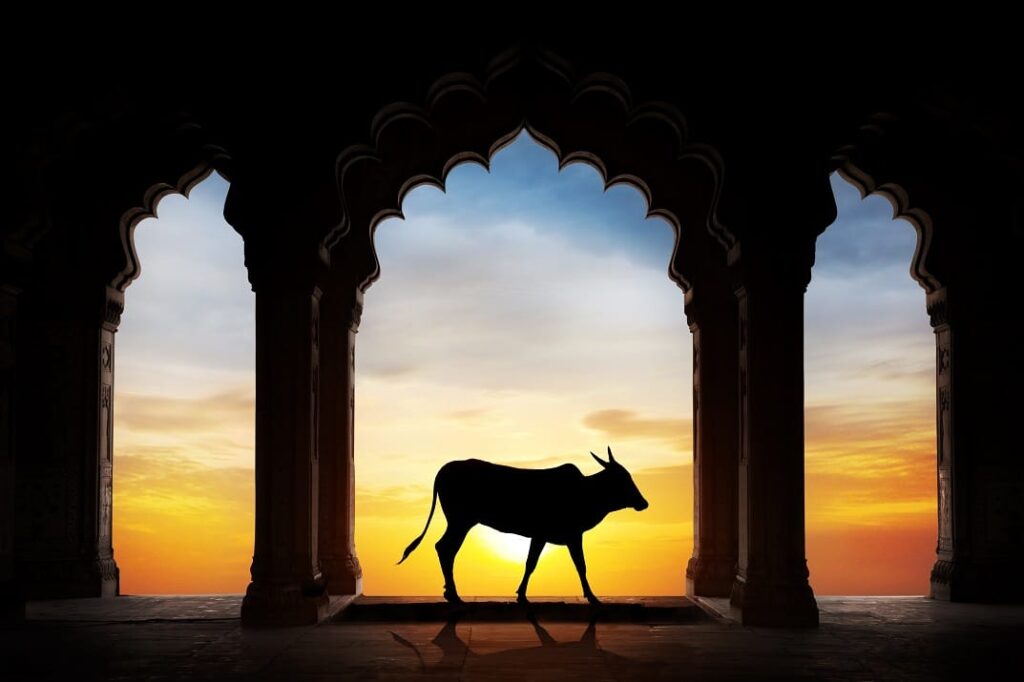
What is gobar gas?
Gobar gas is biogas produced from cow dung. The term was first used in India, where biogas is traditionally made from cow waste from dairy farms — the word “gobar” in Hindi means cow dung.
Gobar gas is produced through anaerobic digestion. Bacteria break down the organic matter in a sealed, oxygen-free environment to produce gas and organic soil products (liquid or solid fertilizer).
Gobar gas is an eco-friendly alternative to natural gas and other fossil fuels. It can help reduce greenhouse gas emissions while also increasing access to clean energy sources for off-grid households in rural areas. Its popularity has been growing not just in developing countries, where it provides communities with cheap energy for heating and cooking, but also worldwide as more governments are looking for alternatives to fossil fuels.
Gobar gas vs. biogas: what are the differences?
In short, gobar gas is biogas, but not all biogas can be called gobar gas.
In general, the term biogas refers to any “a mixture of methane and carbon dioxide produced by the bacterial decomposition of organic wastes and used as a fuel.” (Merriam Webster). It means that biogas can be made from a wide range of raw materials, such as:
- Biodegradable waste from industrial facilities
- Expired food from supermarket shelves, food waste from restaurants, caterers, and households
- Biowaste (including human waste) and sludge from wastewater treatment plants
- Manure, field biomass, and agricultural byproducts from agricultural activities
On the other hand, gobar gas strictly refers to cow dung biogas obtained from the anaerobic digestion of cow dung only. However, the final product isn’t much different, and gobar gas is usually called biogas by subject matter experts and journalists.
Both gobar gas and biogas are popular alternatives to natural gas and other fossil fuels, as they reduce the amount of methane and carbon dioxide emissions in the atmosphere. Numbers can help better understand the potential of this green energy source: the global biogas market size was valued at $60.06 billion in 2021, and its expected annual growth rate between 2020 and 2030 is 4.3%.
Biomethane (purified biogas) is considered a game-changer in the “decarbonization” of the EU economy. The EU has registered a 40% increase in biomethane plants between 2020 and 2021. In Europe, biogas is mainly produced from agricultural waste, animal manure, and energy crops.
The Indian biogas market is valued at $1.47 billion in 2022 and is expected to grow to $2.25 Billion by 2029. In India, animal waste is the primary source of raw material used to produce biogas, and cow dung seems to be one of the resources to support the transition to cleaner energy.
Gobar gas composition
On average, the chemical compositions of biogas and gobar gas are described as:
- 50-70% Methane (CH4)
- 25-50% Carbon dioxide (CO2)
- Residual amounts of nitrogen (N2), hydrogen (H2), and oxygen (O2)
- Traces of hydrogen sulfide (H2S), water vapor (H2O), and ammonia (NH3)
The exact composition of gobar gas can vary with the raw materials (depending on the cows’ nutrition) and the environment where the biogas production occurs.
What’s important to note is that cow dung has a Carbon to Nitrogen ratio of between 25:1 and 30:1, which is considered optimal for biogas production.
Gobar gas production process from cow dung
The process for producing gobar gas is similar to producing biogas from any other source.
It starts with collecting and depositing the cow dung in collection tanks, where the organic matter is mixed until it becomes homogeneous. The slurry is called biomass and is regularly fed into sealed tanks called digesters. The anaerobic digestion occurs in multiple stages inside these containers until bacteria break down all the components to obtain methane and other gases.
The process includes four distinct stages:
- Hydrolysis: bacteria turn complex carbohydrates, proteins, and fats into sugars, amino acids, and fatty acids.
- Acidogenesis: acidogenic bacteria produce volatile fatty acids (VFAs), alcohols, and gases.
- Acetogenesis: acids and alcohols become acetic acid, hydrogen, carbon dioxide, and other gases.
- Methanogenesis: methanogens break down the acids and alcohols into methane.
According to studies, each kilogram (2.2 pounds) of cow manure can produce between 15 and 30 liters of biogas per day and even up to 40 liters per day.
Besides gobar gas, the process also generates digestate, which can be used as organic fertilizer for lawns and, in specific conditions, flowers and vegetable gardens. It boosts plants and improves the soil texture, with a long-term impact on how it holds water and creates an environment where bacterial and fungal activity thrives.
Fertilizer from cow dung has balanced amounts of carbon, nitrogen, phosphorus, and potassium, enabling microbes living in the soil to produce nutrients for plants continuously through natural processes.

Gobar gas uses and applications
Gobar gas can be produced in small digesters at home or on a big scale in large biogas production plants:
- Small-scale biogas digesters can provide a low-cost energy source for lighting, cooling, and cooking. The biogas fuel can be consumed directly or converted into power. Depending on the system’s complexity, electricity could also be produced at small costs. It’s an eco-friendly solution that enables households to be self-sufficient while managing waste with minimal impact on the environment.
- Gobar gas can generate heat, electricity, or heat and power (CHP) plants when it is produced in large quantities in industrial facilities. Depending on the size of the biogas plant, the energy produced can be directly sent to the electricity grid and serve one or several communities. Moreover, the heat produced during the process can also be used to heat pools or buildings nearby. If the biogas is purified to produce biomethane, this can replace natural gas in industrial, commercial, and residential applications. The fuel is easily transportable.
Most domestic biogas systems produce cooking gas, like HomeBiogas, transported to a biogas stove with a standard gas pipe. The process is straightforward, making it easy for households to recycle cow dung (a residual matter that otherwise would end in landfills) and obtain clean, cheap energy.
Gobar gas benefits
Gobar gas is an eco-friendly, renewable alternative to fossil fuels. Used on a large scale, it can impact greenhouse gas emissions and affect climate change.
Gobar gas advantages:
- It uses materials that already exist and would otherwise end in landfills, where it would further impact air quality and pollute soil and water.
- It’s a renewable energy source, and its combustion has a minor impact on the environment than fossil fuels.
- The gobar gas production process doesn’t damage ecosystems and landscapes (on the other hand, fracking is often necessary to extract natural gas).
- It helps reduce methane emissions by preventing manure from decomposing freely on the soil.
- It’s a cheap energy source, accessible to communities in developing countries that wouldn’t have access to clean energy otherwise.
To exemplify gobar gas benefits, let’s take a closer look at this 2021 study on the utilization of cow dung residues of biogas plants for the sustainable development of a rural community in Ziala Village, Bangladesh.
Here’s how a gobar gas plan has benefited the community:
- The community members use rich organic fertilizer, which means they rely less on chemical fertilizer. The soil is protected, the agricultural activities have a smaller impact on the environment, and the plant owners reduce production costs.
- Having cooking gas available improved the cooking environment for families in the community.
- At the same time, the presence of cooking gas reduced the time necessary to collect firewood, which further impacts the preservation of the forest and its resources (including wildlife).
- Biogas plants eventually impacted the environmental conditions and socio-economic profiles, primarily around occupational distribution and education.
Gobar gas disadvantages
When it comes to gobar gas cons, scalability and management of raw material are the most significant.
Whether produced at home or in industrial facilities, gobar gas implies gathering, storing, and managing cow dung. If users don’t observe specific measures and health and safety standards, substances from raw materials can still end in landfills and contaminate water sources. So, waste management must follow the rules and protocols for gobar gas plants to be genuinely eco-friendly and effective.
On the other hand, biogas plants using cow dung can only be effective when they’re implemented close to dairy farms because they need raw material consistently and constantly to function. Therefore, gobar gas production systems aren’t suitable in large urban areas or places where cow dung can’t be easily found and collected.
Gobar gas legislation
While there is no gobar gas-specific legislation, each country has given significant attention to biogas legislation. Laws and regulations vary by country or region and highlight the importance of alternative, green energy sources in today’s world.
The US
- The Farm Bill programs – 2008 Energy Title, especially REAP (Rural Energy for America Program), encourages farmers to produce biogas.
- The 2007 Energy Bill provides incentives for using biogas as a transportation fuel.
- The Federal Renewable Energy Production Tax Credit (PTC) provides a corporate tax credit of 1.3 cents/kWh for electricity generated from alternative sources, including biomass.
The European Union
- The Renewable Energy Directive forces state members to reach specific targets for renewable energy by 2030, with a sub-target for advanced biofuels and biogas. However, the new policy restricts biogas and biomethane production with sustainability thresholds for greenhouse gas savings compared to fossil fuels.
- The REPowerEU Plan makes biomethane and hydrogen a top priority for the EU, as the organization plans to diversify gas supplies.
The UK
- The 2022 Biomass Strategy wants to review biomass sustainability standards and how biomass plants operate.
Asia
- The Indian Ministry of New and Renewable Energy published new power schemes for biomass and biomass gasification.
- China plans to promote the development of biomass energy.

Current and future developments
Dairy cows continue to be one of the most significant contributors to climate change and significantly impact air and water quality worldwide. Every cow produces, on average, 29.5 kg (65 pounds) of manure and between 250 and 500 liters of methane each day, and turning cow dung into biogas can quickly become a cost-effective waste management solution worldwide.
Biogas and, therefore, gobar gas are seen as flexible energy sources that solve a double problem. On the one hand, they provide quick access to energy to communities in rural areas for affordable prices. On the other hand, the biogas production process helps solve the growing issues generated by cow waste polluting landfills, air, and water.
However, clear legislation should be released to ensure that waste management and sustainability standards are observed so gobar gas plants remain sustainable in the long run and indeed provide clean alternatives to fossil fuels.
As technology evolves and gobar gas systems become better at streamlining the biogas production process, we can expect increased adoption in areas where large amounts of cow waste are available.
Conclusion
Gobar gas and biogas are similar products. They both have the potential to reduce greenhouse gas emissions from the atmosphere, with a medium and long-term impact on the environment. However, gobar gas production is geographically limited to the areas where dairy farms can constantly provide the necessary raw material for producing sustainable gas with minimum costs.
In such areas, gobar gas has the potential to significantly impact communities and increase living standards by providing access to cheap energy for heating and cooking while enabling an effective system for cow waste management at scale.







